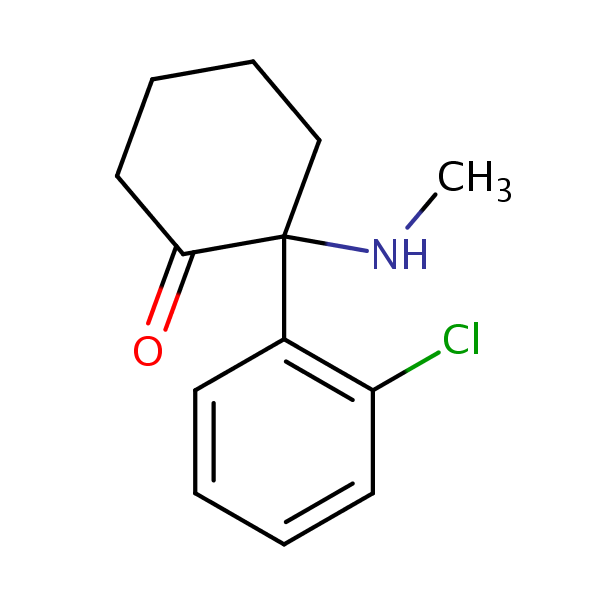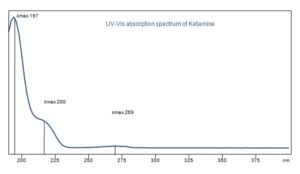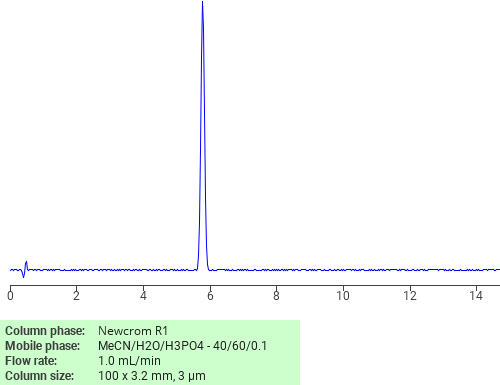| CAS Number | 6740-88-1 |
|---|---|
| Molecular Formula | C13H16ClNO |
| Molecular Weight | 237.730 |
| InChI Key | YQEZLKZALYSWHR-UHFFFAOYSA-N |
| LogP | 2.49 |
| Synonyms |
|
Applications:
HPLC Method for Analysis of Ketamine Form on Primesep B Column
September 29, 2023
High Performance Liquid Chromatography (HPLC) Method for Analysis of Ketamine on Primesep B by SIELC Technologies
Separation type: Liquid Chromatography Mixed-mode
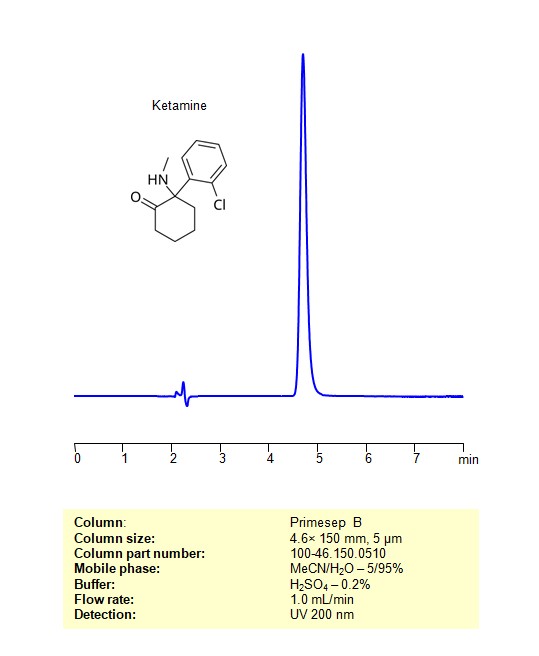
Ketamine is a medication primarily used for induction and maintenance of anesthesia. It also has analgesic and sedative properties.
Ketamine is classified as an arylcyclohexylamine. Chemically, it is known as (RS)-2-(2-chlorophenyl)-2-(methylamino)cyclohexanone.
Ketamine is used primarily as an anesthetic and analgesic in both human and veterinary medicine. It has a unique mechanism of action, acting primarily as an antagonist of the N-methyl-D-aspartate (NMDA) receptor, which is involved in pain transmission and synaptic plasticity.
Beyond its primary medical use, ketamine has also been investigated for its rapid-acting antidepressant effects and is used in certain treatment-resistant cases of depression.
Due to its potential for misuse and the hallucinogenic effects it can produce at sub-anesthetic doses, ketamine is also classified as a controlled substance in many countries.
Ketamine can be retained, and analyzed on a Primesep B mixed-mode stationary phase column using an isocratic analytical method with a simple mobile phase of water, Acetonitrile (MeCN), and a sulfuric acid as a buffer. This analysis method can be detected using UV at 200 nm.
High Performance Liquid Chromatography (HPLC) Method for Analyses of Ketamine
Condition
| Column | Primesep B, 4.6 x 150 mm, 5 µm, 100 A, dual ended |
| Mobile Phase | MeCN/H2O – 5/95% |
| Buffer | H2SO4 – 0.2% |
| Flow Rate | 1.0 ml/min |
| Detection | UV 200 nm |
| Peak Retention Time | 5.56 min |
| LOD * | 200 ppb |
*LOD was determined for this combination of instrument, method, and analyte, and it can vary from one laboratory to another even when the same general type of analysis is being performed.
Description
| Class of Compounds | Drug, arylcyclohexylamine |
| Analyzing Compounds | Ketamine |
Application Column
Primesep B
Column Diameter: 4.6 mm
Column Length: 150 mm
Particle Size: 5 µm
Pore Size: 100 A
Column options: dual ended

HPLC- MS Method for Analysis of Ketamine on Primesep 100 Column
September 25, 2023
HPLC Method for Analysis of Ketamine on Primesep 100 by SIELC Technologies
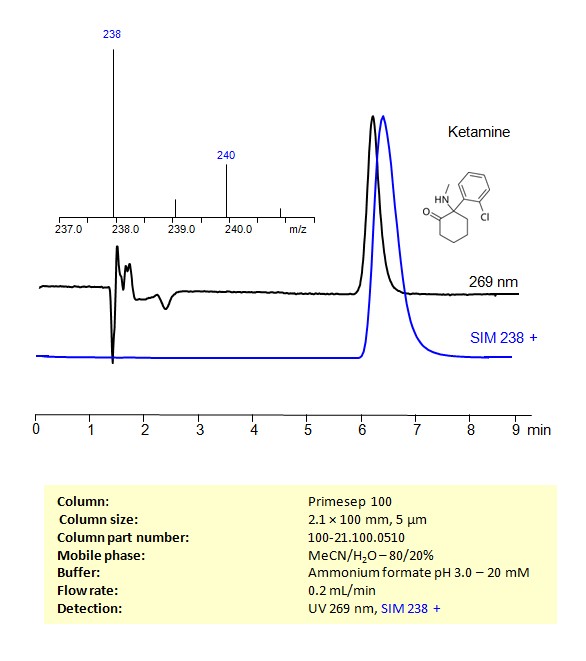
High Performance Liquid Chromatography (HPLC) Method for Analysis of Ketamine
Ketamine is a medication primarily used for induction and maintenance of anesthesia. It also has analgesic and sedative properties.
Ketamine is classified as an arylcyclohexylamine. Chemically, it is known as (RS)-2-(2-chlorophenyl)-2-(methylamino)cyclohexanone.
Ketamine is used primarily as an anesthetic and analgesic in both human and veterinary medicine. It has a unique mechanism of action, acting primarily as an antagonist of the N-methyl-D-aspartate (NMDA) receptor, which is involved in pain transmission and synaptic plasticity.
Beyond its primary medical use, ketamine has also been investigated for its rapid-acting antidepressant effects and is used in certain treatment-resistant cases of depression.
Due to its potential for misuse and the hallucinogenic effects it can produce at sub-anesthetic doses, ketamine is also classified as a controlled substance in many countries.
Ketamine can be retained, and analyzed on a Primesep 100 mixed-mode stationary phase column using an isocratic analytical method with a simple mobile phase of water, Acetonitrile (MeCN), and a ammonium format as a buffer. This analysis method can be detected using UV at 269 nm, an Evaporative Light Scattering Detector (ELSD), or any other evaporative detection method (CAD, ESI-MS)
| Column | Primesep 100, 2.1 x 100 mm, 5 µm, 100 A, dual ended |
| Mobile Phase | MeCN – 80%, |
| Buffer | Ammonium Formate pH 3.0-20 mM |
| Flow Rate | 0.2 ml/min |
| Detection | UV, 269 nm, SIM 238 + |
| Spray Voltage: | 1.5 kV |
| Nebulizing gas: | 1.5 L/min |
| Drying gas: | 15 L/min |
| DL temp: | 250 ˚C |
| Heat Block: | 400 ˚C |
| Class of Compounds | Drug, arylcyclohexylamine |
| Analyzing Compounds | Ketamine |
Application Column
Primesep 100
Column Diameter: 2.1 mm
Column Length: 100 mm
Particle Size: 5 µm
Pore Size: 100 A
Column options: dual ended

HPLC Method for Analysis of Ketamine Form on Primesep 100 Column
September 25, 2023
High Performance Liquid Chromatography (HPLC) Method for Analysis of Ketamine on Primesep 100 by SIELC Technologies
Separation type: Liquid Chromatography Mixed-mode
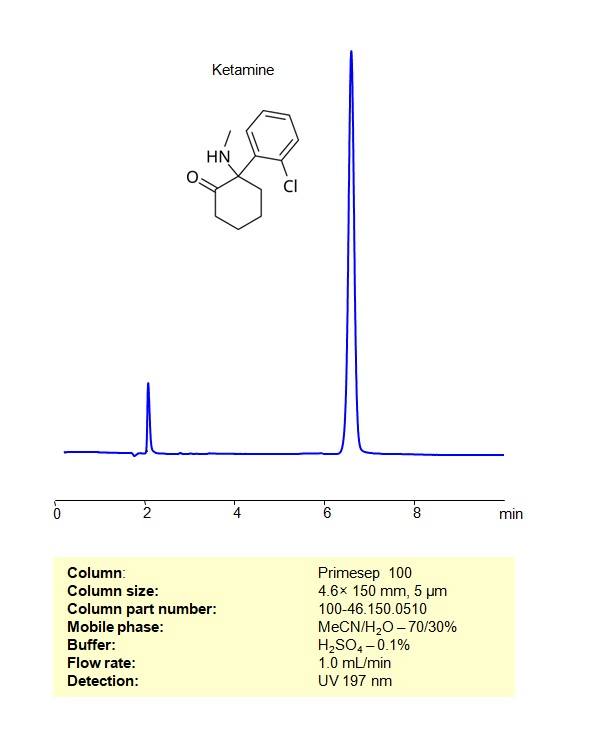
Ketamine is a medication primarily used for induction and maintenance of anesthesia. It also has analgesic and sedative properties.
Ketamine is classified as an arylcyclohexylamine. Chemically, it is known as (RS)-2-(2-chlorophenyl)-2-(methylamino)cyclohexanone.
Ketamine is used primarily as an anesthetic and analgesic in both human and veterinary medicine. It has a unique mechanism of action, acting primarily as an antagonist of the N-methyl-D-aspartate (NMDA) receptor, which is involved in pain transmission and synaptic plasticity.
Beyond its primary medical use, ketamine has also been investigated for its rapid-acting antidepressant effects and is used in certain treatment-resistant cases of depression.
Due to its potential for misuse and the hallucinogenic effects it can produce at sub-anesthetic doses, ketamine is also classified as a controlled substance in many countries.
Ketamine can be retained, and analyzed on a Primesep 100 mixed-mode stationary phase column using an isocratic analytical method with a simple mobile phase of water, Acetonitrile (MeCN), and a sulfuric acid as a buffer. This analysis method can be detected using UV at 197 nm.
High Performance Liquid Chromatography (HPLC) Method for Analyses of Ketamine
Condition
| Column | Primesep 100, 4.6 x 150 mm, 5 µm, 100 A, dual ended |
| Mobile Phase | MeCN/H2O – 70/30% |
| Buffer | H2SO4 – 0.1% |
| Flow Rate | 1.0 ml/min |
| Detection | UV 197 nm |
| Peak Retention Time | 6.36 min |
| LOD * | 200 ppb |
*LOD was determined for this combination of instrument, method, and analyte, and it can vary from one laboratory to another even when the same general type of analysis is being performed.
Description
| Class of Compounds | Drug, arylcyclohexylamine |
| Analyzing Compounds | Ketamine |
Application Column
Primesep 100
Column Diameter: 4.6 mm
Column Length: 150 mm
Particle Size: 5 µm
Pore Size: 100 A
Column options: dual ended

Separation of Ketamine on Newcrom R1 HPLC column
May 16, 2018
Ketamine can be analyzed by this reverse phase (RP) HPLC method with simple conditions. The mobile phase contains an acetonitrile (MeCN), water, and phosphoric acid. For Mass-Spec (MS) compatible applications the phosphoric acid needs to be replaced with formic acid. Smaller 3 µm particles columns available for fast UPLC applications. This liquid chromatography method is scalable and can be used for isolation impurities in preparative separation. It also suitable for pharmacokinetics.
Application Column
Newcrom R1
The Newcrom columns are a family of reverse-phase-based columns. Newcrom A, AH, B, and BH are all mixed-mode columns with either positive or negative ion-pairing groups attached to either short (25 Å) or long (100 Å) ligand chains. Newcrom R1 is a special reverse-phase column with low silanol activity.
Select options